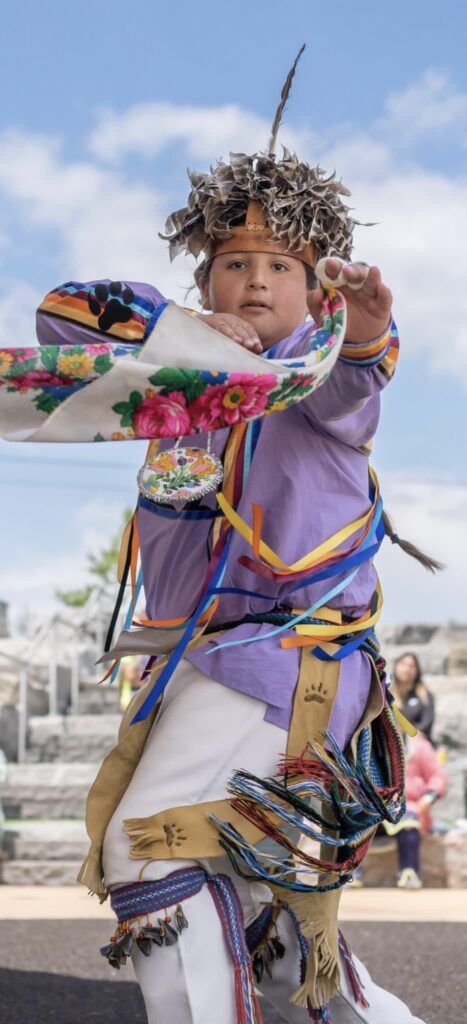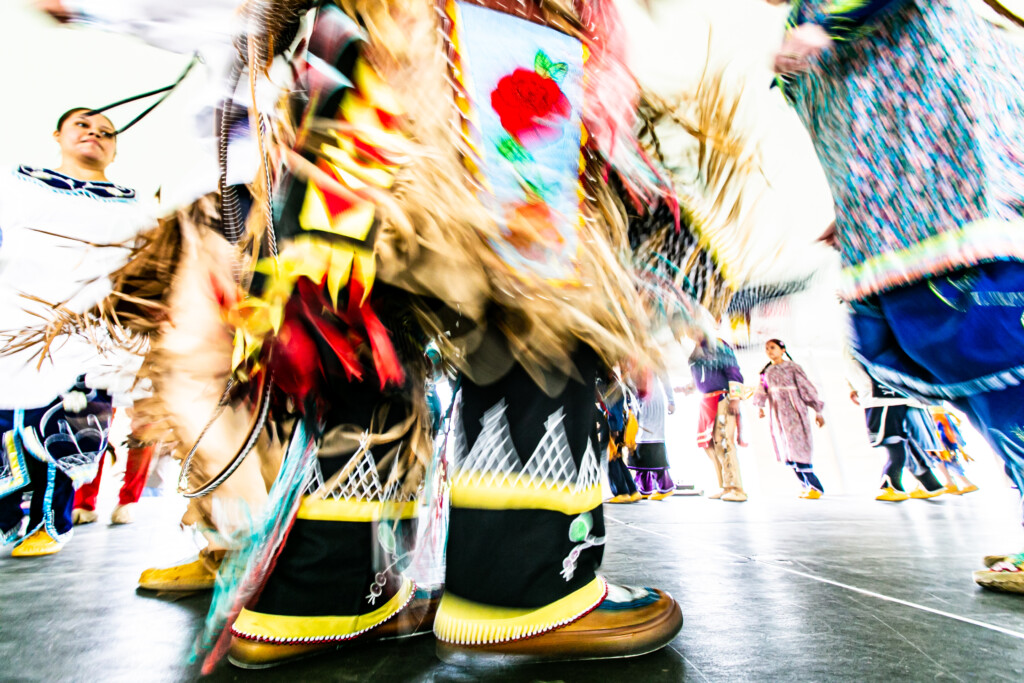With a propulsive rhythm keeping time, a kinetic energy begins to move through the dancers as their vibrant costumes orbit the space around them. Headdress feathers stretch skyward and clusters of beads, carried on the backs of leather fringe, whip back and forth through the air. Firmly planted in the center of all this grandeur is the steady drumbeat, acting as a grounding agent to keep dancers connected to the earth the same way a heartbeat keeps one connected to life.
So goes a performance by the Indigenous Spirit Dancers, a group whose mission is to spread cultural awareness through song, dance, and storytelling. They perform all across the state and beyond: at the Buffalo History Museum, Buffalo Sabres Hockey, parades, conferences in Philadelphia, and, most recently, at Ganondagan’s Indigenous Music & Arts Festival.
Martin Jimerson Jr., the founder of the Indigenous Spirit Dancers, started his passion project just ten years ago, but the seeds were planted early. Growing up as a member of the Seneca Nation of Indians, his dad and uncle performed at the Erie County Fair and at the New York State Fair, where his father was the head singer and his uncle was superintendent of the Iroquois Indian village. As he watched them, Jimerson knew this was something he wanted to do, too. After stepping in to help a friend lead a show, he gained some experience for himself and began to ask others for advice on how to run a dance program of his own. He started small, with only two female and two male dancers. Jimerson recalls it wasn’t long before he had to officially name the group, with people asking him, “what do we call you?” He came up with Indigenous Spirit Dancers, and the group started to perform more frequently. Eventually, they added singers to the mix and these days travel as a group of eight: six dancers and two singers.
Culture is sewn into every facet of performance, so it’s important to know the origins of the group, which is made up entirely of Haudenosaunee dancers. Haudenosaunee are the “People of the Longhouse,” also known as the Iroquois Confederacy. In its current iteration, the confederacy includes six tribes: Seneca, Cayuga, Oneida, Mohawk, Onondaga, and Tuscarora. These roots often inform the costumes that the dancers wear. Their traditional ribbon shirts and skirts are handmade and usually include intricate beadwork. Headdresses worn by the men are made of wood splints with turkey and eagle feathers; the feathers help identify which nation the dancers are from. Clans can be represented on the costumes as well. Some of the clans are beaver, wolf, turtle, bear, deer, hawk, heron, and snipe. As the Haudenosaunee are a matrilineal society, it is the mother’s clan that gets passed down to the child. Music is another component of the culture, and all the songs performed at a show have been passed down for generations. It is the men’s responsibility to sing, and learning the songs requires a lot of practice. Most singers use two main instruments: the water drum and a horn rattle. The drumbeats represent the heartbeat, and all these elements combine to make music that is uplifting or what Jimerson refers to as “good medicine.”
There are several different dances that can make their way into a show, each with a different focus of celebration.
The Stomp Dance is the first dance of the performance. This is a call-and-response dance; the men line up single file, one sings lead and the others respond with a chant. The women then enter the dance, staggered in the line between the men.
The Women’s Dance is performed by women only. Women are held in high regard in Indigenous culture, as they are the life givers and the ones who elect any titleholders within the tribe. The Women’s Dance celebrates their gifts and what they bring to the tribe.
The Round Dance is an intertribal dance performed at powwows, which are attended by many nations. There are two circles in the round dance, with women making up the inner circle and men dancing in the outer circle.
Socials are often held in the Indigenous community and are the best place to indulge in culture; since there are no formal dance lessons required to join a group, most people come to know the dances in an organic way. “This is where the little ones learn,” Jimerson explains, “by observing and participating.” People come to hear drumming and singing, to dance, and to eat. Socials are held to celebrate birthdays and graduations, or as a benefit for someone struggling with health issues. They are also held for the passing of a community member, though at these gatherings, the drums and rattles are put away out of respect for the family. There can be many reasons to hold a social, but they are always held with one hope: “Our traditional socials are meant to bring the people together,” says Jimerson.
This spirit of unity is what fuels Jimerson’s work with the Indigenous Spirit Dancers. By keeping the dances alive, the group creates a bridge for traditional customs to travel to the modern world. Performing the dances educates people and allows them to partake in a culture that is very rich and still very much alive.
The feedback Jimerson receives reflects a newfound appreciation, with spectators calling his shows “excellent, very informative,” and some confirming they had no idea about the customs integrated into the shows. Occasionally, Jimerson is approached by people who remember him from previous shows and want to express their gratitude for what they saw. Ultimately, this is all part of the mission, because while music and dance are the highest form of celebration, sharing it with others is the best way to stay connected.
Views: 25






